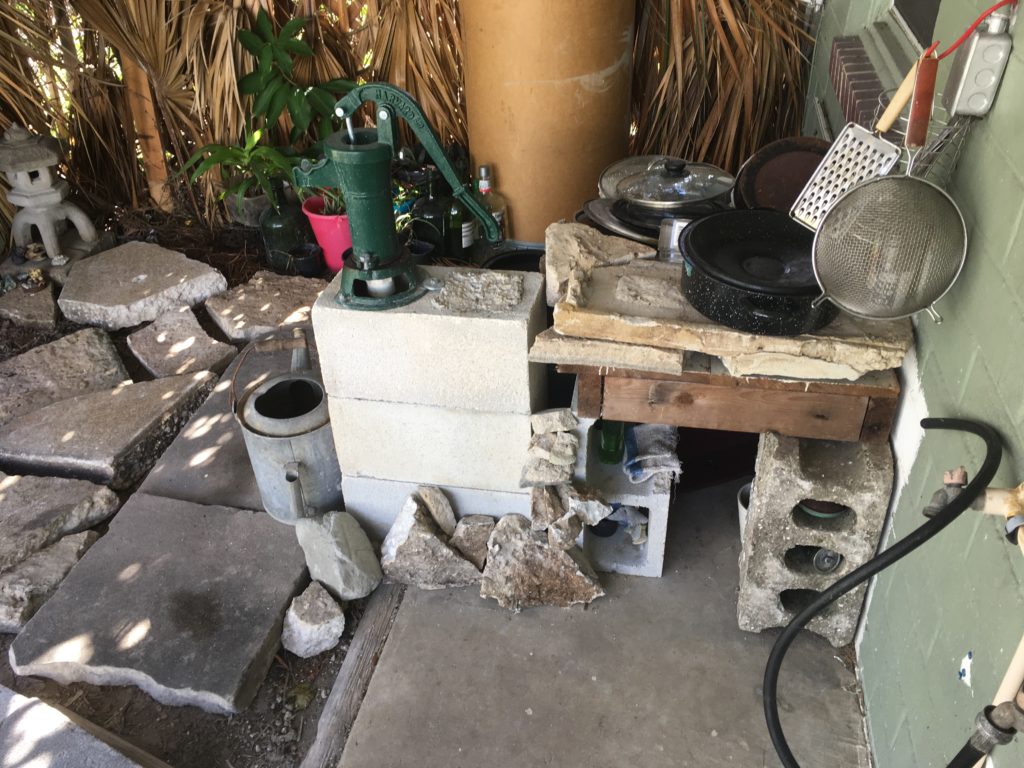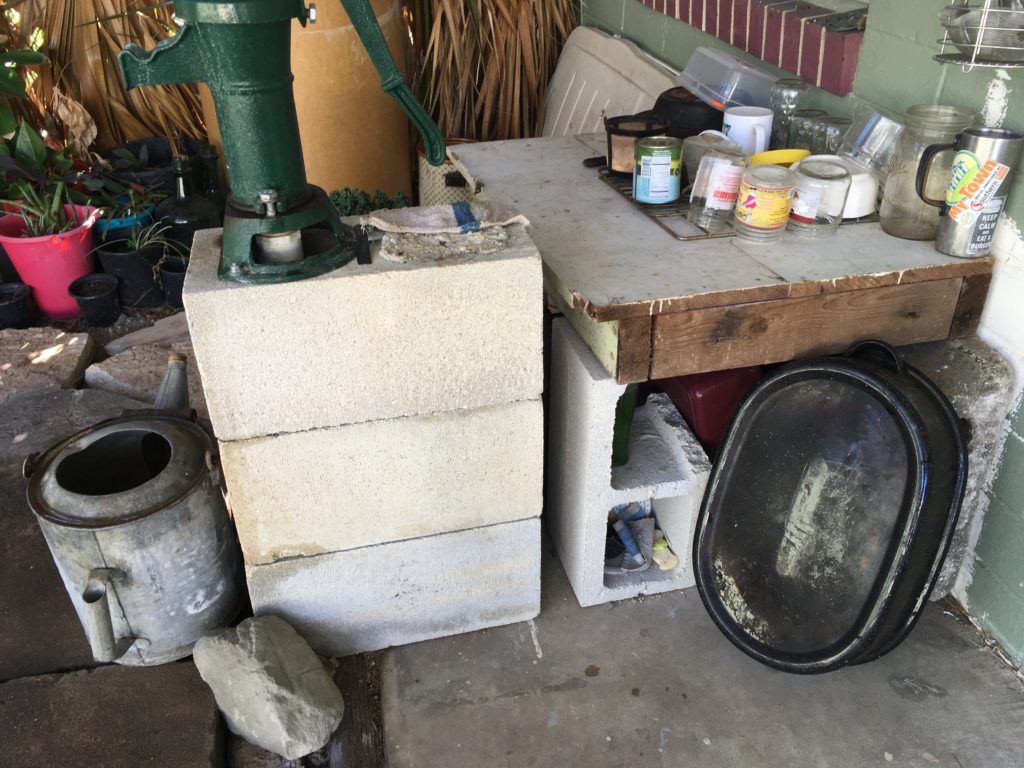Part 1 of my “Fridgeless Experiment” took place in Austin TX in the summer of 2011. You can read about it here. Nutshell, a lot of things don’t need to be refrigerated, and it isn’t all that big a deal to do without a fridge. Living within walking distance of a food market definitely makes it easier, as does growing at least a few of your own greens and fruits, and knowing your local wild edible plants.
Recently I decided to have another go at fridgeless living. I’ve had my fridge unplugged since just after Thanksgiving. (I have actually gone fridgeless at a few points since my first effort back in 2011, but since I’ve mostly been living with roommates since then, the experiments have been limited to short durations of a few days at a time.)
From my current round of fridgeless living, here are some of my tips for food shopping and storage:
I grocery-shop once a week, at my local Saturday farmers’ market. Although produce doesn’t need to be refrigerated, it does fall into perishability categories, from “must use quickly” (berries and other soft-skinned fruits; veggies such as lettuces and broccoli) to “lasts longer” (apples, citrus fruits, cabbage, potatoes). I keep most produce in the coolest, shadiest corner of my shaded patio, as opposed to indoors.
Berries, star fruit, other soft-skinned fruits: I always plan to eat them that same day or the next day. Strawberries and other berries will keep overnight but not much longer. If I buy raspberries I eat them right away (not only because they’re perishable but also because they are an irresistible special treat)! Save the more durable fruits such as apples, bananas, citrus for later in the week. Watermelon: SHARE! Buy with sharing in mind. If any fruit was meant to help people form closer bonds with their neighbors, surely it is the wonderful watermelon. Or, you can buy one of those mini melons and eat half one day and half the next day.
Broccoli: Eat the floret part within one or two days. I cut off the tops to eat right away (aim to finish eating them within two days of purchase, which for me means finish them by Sunday evening). The tougher “trunk” of the broccoli can be grated, and along with carrots and cabbage, makes a delicious ingredient for slaw. That broccoli “trunk” lasts for days. What I have been doing for storage is take the broccoli, and also the carrots and put them in a shallow tub of water. (I use one of the veggie storage drawers from the fridge for this purpose.) I take the tops off the carrots and stick those in their own widemouthed mason jar like a vase. Carrot tops last a few days. UPDATE: It turns out that carrots themselves keep for several days in water as long as the air temperature is cool, say in the 40s at night and no higher than the mid-60s in the daytime. But once the temps started getting more “normal” for us Floridians, I noticed the carrots getting soft spots and eventually going completely bad after 3-4 days. I may experiment with adding vinegar to the water. And eating up the carrots faster!
Dressings and condiments: generally do not require refrigeration. Then again I don’t use mayonnaise or anything that contains mayonnaise. If I used mayonnaise I would be worried about leaving it unrefrigerated.
Cheese: lasts for days outside the fridge. Butter doesn’t need to be refrigerated. In summer in hot places, the liquid separates out and the butter goes all to mush, which is probably why our friends in India invented ghee.
Yogurt: Can keep outside the fridge for a few days, especially in cool weather.
Meat: I have heard that ceviche (fresh fish “cooked” in lime juice) will last for several days unrefrigerated. Have tried that for 2-3 days and it was fine. Other meats, I either eat on the spot (at a restaurant) or eat the leftovers by the next day. I wouldn’t advise anyone to leave meat sitting out overnight, though I do it all the time and have never experienced ill effects. Raw meat, I would never leave out.
Tofu: I would buy in small batches if I could, and use quickly. In Austin I knew a woman who had a tofu-making business. Maybe there is one where you live. Or an Asian supermarket that sells tofu in bulk, so you can bring your own container and only get what you need that day. I once ate a tofu wrap that had been sitting out overnight in summer and it was fine, but I would not advise anyone else to assume that would be fine.
Eggs: They supposedly keep for a long time outside the fridge and only go bad if they are washed. (In the USA they usually are washed, unless you get yours straight from your own chickens or a friend’s chickens).
Ice: I generally only use ice in summer, and even then only as an occasional treat. (My joke, as a person who doesn’t like the cold, is “Don’t even SAY the ‘I-word’ to me between October and May!”) When I have guests, we buy a bag of ice and keep it in a cooler. The ice can keep for days if stored in the shade in a well-insulated cooler. And actually, a lot of the friends who come stay with me are likeminded, so we don’t even always buy ice.
My weak spot: is/was cream for my coffee. Right now I’m drinking it black. Sometimes I buy a can of evaporated milk but that will only keep for a couple days outside the fridge so it would be a waste unless we get a spell of really cold weather. If you live up north, it’s easy for you to have cream in your coffee without a fridge, at least in winter. I’ve had condensed sweetened milk last for up to 5 days outside the fridge, but I don’t generally like sweetened coffee so I usually don’t go for that option.
I still have my fridge, so I can plug it back in anytime if I have extended guests or a longterm housemate. In the meantime, I’m enjoying the experiment which has cut my electricity consumption in half. Note, doing without a fridge is not likely to cut your electricity consumption in half, unless you are like me and are already going without heat, air-conditioning, clothes-dryer, and water-heater. It will cut your consumption significantly though — by about 13%, according to Department of Energy data quoted on Michael Bluejay’s “Mr. Electricity” website.
Besides saving a bit of money and a considerable amount of electricity, what’s the point of doing without a fridge? For me, besides those benefits, there’s also the very significant benefit of improved self-reliance; household preparedness. Knowing I can do without a fridge, I feel much less vulnerable to power outages. Thanks to this experiment and my various other steps to reduce my dependence on electricity, I really don’t worry about power outages, and I’m better equipped to help other people deal with outages. If you try a fridgeless experiment, let me know how it goes and what you learn!
Resource Alert: My 2011 “Fridgeless Experiment” post was originally published on the Austin EcoNetwork blog. Whether or not you live in Austin, AEN’s site is a valuable resource for green living and activism.





